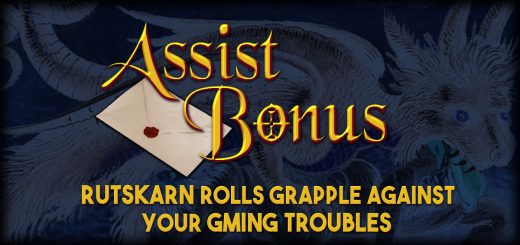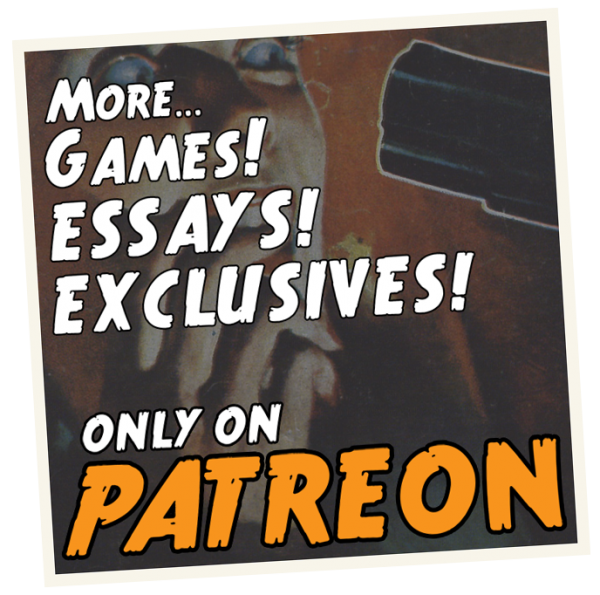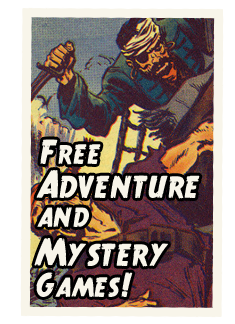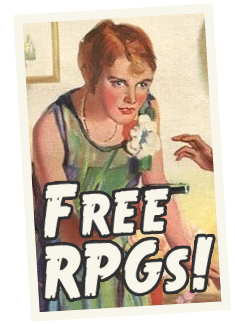Assist Bonus: How To Motivate Players? (Part One: Goals)
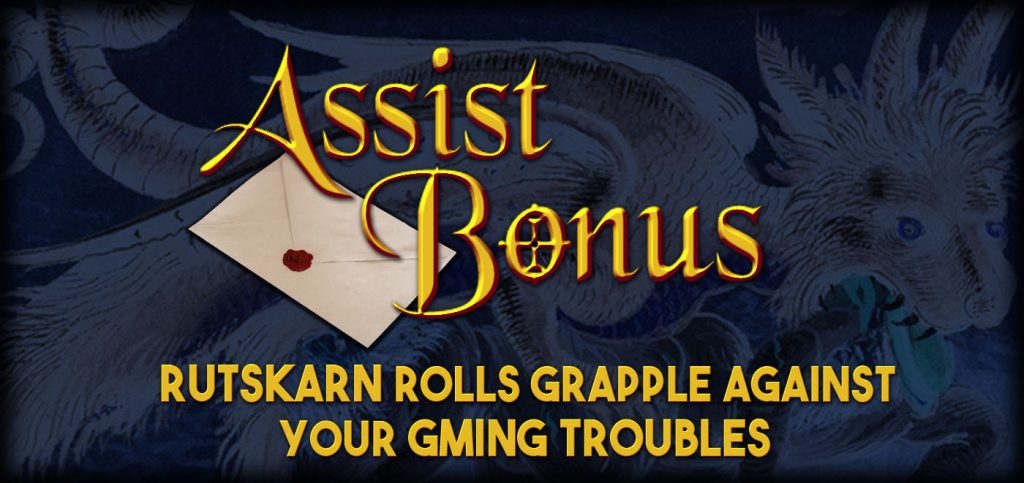
How do you plan an actual plot? I always have trouble doing anything where things connect in that way from session to session beyond being the obvious next place to explore, and my players complain that they lack motivation and wonder what the goal is.
-Cuthalion
As you may have guessed, this question’s thick as a hog and as hard to get a grip on, but I’ll have to save my deep dive on developing narratives for the next entry. First, I’ve got some good news for you.
You’ve said you’re having trouble creating a multi-session connective plot. You’ve also said your players need concrete and externally-provided goals. Not unfairly, you’ve connected these problems—most GMs associate fixed player goals with a narrative campaign and the absence of player goals with an unstructured sandbox. But the reality is, they’re not intertwined at all. Building up your narrative skills may or may not lead to more enjoyable campaigns, but to address your player’s complaints, you’ll need a different (and, I believe, much more accessible) toolkit.
To explain why, let’s talk about the three story burdens GMs carry. Not every campaign features every element, but these are all things which players might ask for that GMs traditionally provide:
- Narrative. This is what you seem to be struggling with: overarching storylines with characters, relationships, events, schemes, etc. If you were to “outline” your campaign’s story ahead of time (something I don’t do, but which I understand many GMs recommend), then these are the acts and twists and story beats you’d be jotting down. This is stuff I’ll talk about in the next part, but not the stuff I think will actually help you.
- Context. If narrative is the campaign’s outline, context is the campaign’s notes. Maps, lore, setting info, NPCs, factions: all the stuff you need to provide descriptions, adapt to player improvisation, rule on answers to unexpected questions, and add flavor to the game. Many successful campaigns are run just from this raw material, but even if players don’t feel the need for an overarching narrative, they might still feel lost without…
- Externally-Imposed Goals. Things you come up with for players to do. The PCs will blank because they want to achieve outcome blank. The GM usually draws from the narrative, context, or both in designing these.
I’m not splitting hairs by distinguishing narrative from player goals; in an extremely real and practical sense, they’re divorced. A game can have a brutally thin narrative and very compelling external goals, or it can have a rich narrative that fails to provide actionable, intelligible hooks—either because players don’t want them or the GM can’t devise them.
To illustrate why, let’s design a campaign together. Assume we’ve got two limitations:
- Our players hate supplying their own motivations and require us to come up with external goals.
- We have a rare tropical disease which makes us break out in boils if we spend more than a minute (or sentence) coming up with each session’s storyline. If we try to plan two sessions in advance, we’ll wake up in quarantine surrounded by doctors who don’t legally exist.
In other words, our game will have firm external goals and a paper-thin narrative. We’ll call this magnum opus Orc World, because “orc” was the first page of the Monster Manual we flipped to. Despite our limitations, our goal is to provide our players with consistent and emotionally resonant objectives which carry them through a simple but fun campaign.
See, we may not know how to string a story together, but we won’t need to. All we need to know is that a good GM-imposed player goal (or “quest,” a simpler if less precise term) will provide clear answers to these three questions:
- How is it fun for the players? Will the challenges, adventures, puzzles, and battles the quest suggests be enjoyable?
- What do their characters get out of it? Is there a plausible in-character incentive for them to undertake the quest?
- Why would they care? Is that in-character incentive desirable or emotionally satisfying to the player?
Don’t sleep on that last requirement. Your game improves considerably when you realize that rewards which are intrinsically motivating in real life aren’t necessarily compelling in a game. Otherwise, Monopoly would be a non-stop thrill ride. The reason it’s boring to pass GO-> and collect $200 is that there’s nothing fun to do with your little paper hoard; buying properties and then hoping someone steps on them is a hands-off, random, and emotionally numbing pastime. On the other hand, scoring boring-ass bricks in Catan makes me excited because they enable me to pursue all sorts of active, risky, and immediately satisfying strategies. Remember this when you’re dangling treasure in D&D; they might not care about an imaginary hoard of gold unless they can do imaginary cool stuff with it, so dangle cool artifacts or hit them with debilitating debts before you tease that glittery dragon’s lair. Even the ultimate implicit motivator, death, is impotent if handled poorly. Players fear danger only if they’re invested in their characters—or if you make the peril visceral enough that they’re forced to empathize with their characters, a strategy you’ll have to resort to early in the campaign. Finally, players won’t sweat the fate of a game world unless they already enjoy being a part of it.
Our one-sentence session outlines for Orc World won’t be fancy, but as I’ll demonstrate, each will satisfy the three criteria. I’ll also provide an example of how we can highlight a loose end or player reaction from each session to build the next session’s outline from.
FIRST SESSION
OUTLINE: The party needs to escape an orcish prison fortress before they’re executed like the other captives.
This will be fun for the players because there’s combat, sneaking, cunning, and adventure involved. Their characters will get their lives and freedom out of it. This will be emotionally compelling because the other prisoners will have a gruesome execution at the start of the adventure, making escape feel like an urgent necessity.
Session Report: The players narrowly manage to escape, but raise an alarm as they do so.
SECOND SESSION
OUTLINE: The party needs to cross the border into Humanworld before the orcish inquisitor and his team of wargs catch up to them.
This will be fun for the players because it’ll match their wits against a powerful opponent. Their characters will get their lives and freedom, once again. This will be emotionally compelling because once they’re across the border, they’ll have achieved the safety which had been their goal for two sessions straight, providing not just relief but satisfaction at the culmination of an arc.
Session Report: They elect to avoid the marshal the entire session, afraid that he’s too dangerous to fight, but as the cat-and-mouse game plays out they develop a serious grudge against him. Eventually they cross the border.
THIRD SESSION
OUTLINE: A formidable ranger suggests teaming up with the party to hunt down the orcish marshal and assassinate him before he gets back to his men.
This will be fun for the players because it’s a neat combat with a powerful ally’s abilities to play with. Their characters will get revenge on their pursuer and additional peace of mind out of it. This will be emotionally compelling because the players will be delighted to be rid of their own appointed nemesis.
Session Report: The players defeat the orc marshal, but the ranger is killed. Somewhat surprisingly, the players seem saddened by his death.
FOURTH SESSION
OUTLINE: The players follow a lead in the ranger’s journal, bearing his body through a deadly swamp to a druid who can bring him back to life.
This will be fun for the players because there’s lots of cool traps, curses, and monsters you can come up with for swamps. Their characters will get their old friend’s life out of it. This will be emotionally compelling because they were sad he died and will be pleased to resurrect him.
Session Report: They get through the swamp and resurrect him. As they do so, they wonder aloud where all these bizarre swamp monsters are coming from.
…and so on.
You may have noticed that our quest hooks began as very general (“stay alive, don’t die”) and gradually became more specific to what happened in the last session. Your own campaign should follow a similar trajectory. As you come to understand your players, noting what sub-goals motivate them and how they emotionally respond to challenges and NPCs, you’ll get better at creating quests catered directly to their interests and personalities. In this respect, freedom from a fixed and overarching story isn’t a hindrance at all—it’s an asset.
I’m sure you’ll agree that there’s nothing complex or urbane about this campaign’s narrative; it wasn’t planned in advance, and the story is simplistic and wholly improvised from session to session. There are no world-saving artifacts, conspiracies, or devious archvillains to strain over. Yet it provides the group the sense of directed and motivated adventure they were looking for, because at every turn the GM is considering what they might want and how they could earn it in a satisfying way.
These are the chief principles you’ll want to consider and apply within your campaign. Next time, I’ll meet your question head-on and talk about how to construct useful and satisfying overarching plots.

